Archives for Geek Out! category
Posted on Oct 17, 2011 under Geek Out!, Raves |
I have to admit, when the aquapulse was 1st announced I got pretty excited: I’m all about training with data and in the pool I’d always felt that I was “data blind” especially when compared to cycling and running. Enter the Aquapulse:
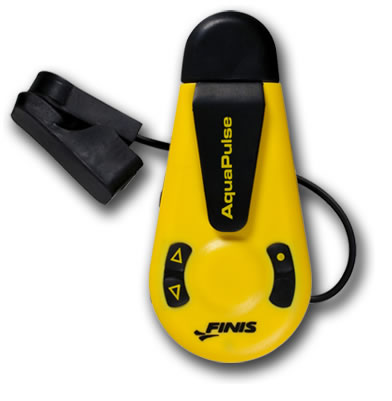 The Aquapulse clips onto the strap of your swim goggles and onto your earlobe. It uses a beam of light through your lobe to sense your heart-rate and speaks it via bone conduction into your head.
The Aquapulse clips onto the strap of your swim goggles and onto your earlobe. It uses a beam of light through your lobe to sense your heart-rate and speaks it via bone conduction into your head.
I tested the Aquapulse in my masters swim class over the last few weeks and I have to say, I’m pretty impressed:
- One of my 1st concerns was that I had pierced ears. Not just pierced, but pierced and once stretched to .75″ holes. The holes have since shrunk, but I hardly have “normal” ear-lobes. I wondered how the sensor would work on my deformed lobes. I was happily surprised that there was absolutely no issue having the Aquapulse find and track my pulse. I did spend a little time making sure the sensor was over flesh and not air, but otherwise it was just clip and go.
- Comparing the Aquapulse to the heart-rate telemetry from my Polar RCX5 and to fingers on the wrist/eyes on the clock, I found it very accurate.
- I already wear swim goggles (and I assume you do as well, if not you would probably prefer a watch-style device) and found the Aquapulse more swimmer friendly than a heart-rate watch and chest strap. Its audible reporting of pulse avoids having to interrupt your stroke to check your pulse and allows you to adjust your intensity mid-set based on its prompting. I also find the chest straps annoying when doing pure swim workouts and that flip turns would frequently dislodge the strap. Further, we aren’t allowed to wear watches in our masters swim class but there’s no issue with a mask-strap-attached device.
- I wear earplugs when I swim and the bone conduction is awesome (similar to the swimp3). In fact, with the earplugs I find the bone conduction better than without, probably due to the lack of other external competing noise. I did find the diction took a little time to get used to, but after 20-30 minutes of listening to the Aquapulse, you get to understand how it “speaks” and life is good.
- The battery life is great. I charged the device when I first received it, have used it for roughly 6 hours on that initial charge and its still going strong. I’m not sure how long the battery is supposed to last, but at over 6 hours that’s amazing.
In all, I think the Aquapulse is a great training aide. (Like so many of Finis’ products.) It’s well thought out, easy to use, and provides useful, timely and valuable feedback to the athlete while they train. No, you’re not likely to use it in a race environment (like you may with a multi-sport wrist-computer), but as a purpose built training aide, it has no rival.
Posted on Oct 14, 2011 under etc..., Geek Out! |
Hey Folks! Sorry for the radio silence of late. A couple of quick tid-bits and more to come soon.
1) I’m injured. There I said it.. and it freaking sucks! My trail run 1/2 marathon in Palo Alto a few weeks ago, combined with all the walking I did while in the Bay Area, strained a hip flexor and developed a condition called “hip click syndrome”. Technical eh? It’s a bursitis of the hip flexor tendons that actually causes clicking when I lower my knee from a raised position. Running (well walking for that matter) has been completely wiped out and only in the last few days have I been able to walk about 2k without pain. Swimming has been ok, provided I haven’t kicked, and fortunately cycling has been unaffected.
The good news is that it does seem to be improving. Hopefully in the next week or so, I can start adding small runs back into my training schedule.
2) In the mail the other day a package from Finis arrived with an Aquapulse, a Swimsense, a swim cap and set of goggles. I’ve been testing the aquapulse in my masters swim classes and will be posting a comprehensive review over the weekend.
Posted on Aug 14, 2011 under Geek Out! |
After my review of the Polar RCX5, a number of you reached out to me asking my opinions on the Garmin 310XT.
I’ve been trying to reach Garmin to setup an evaluation, but, to date, they’ve been unresponsive. If anyone has a contact at Garmin’s marketing dept who could help get this going, it’d be appreciated.
From the specs online the 310XT looks interesting and none of the 3 devices I’ve looked at is a perfect solution for the multi-sport athlete. I’d really like to see how the 310XT measures up. Anybody?
Posted on Jul 17, 2011 under fitness, Geek Out!, Raves |
A few weeks ago I was very fortunate to receive an evaluation RCX5 from Polar to review for the readers of my blog. I’d hoped to get the complete configuration, that included the watch, hrm, gps, foot pod, and bike cadence and speed sensors; however, unfortunately, there are no gps units to be found. 🙁 That being said, Polar did ship me all the other parts of the kit for evaluation. Pretty awesome!
First Impressions
My current training watch is the Timex Ironman Global Trainer. I generally like the Timex, but it’s not without it’s problems: it’s huge, needs constant charging, and the HRM transmitter is not compatible with the powermeter cpu on my bike. When I unpacked the RCX5 I was immediately struck by how much smaller it is than my timex.
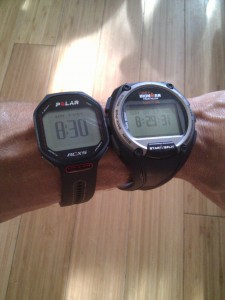
Timex Global Trainer vs RCX5 Size Comparison
The polar is small and stylish enough that you could just wear it as a day to day watch. This makes sense as the GPS functionality that’s built into the Timex is a separate piece of equipment with the RCX5.
Swim
The evaluation kit arrived at my office on a Friday afternoon a few weeks ago. Lately Fridays have been my open water swim day. This Friday was not an exception and I was eager to take the RCX5 into the water. Not having hrm data from my swim sessions, I find very annoying. (Yes I’m a data monkey, I know it. As a triathlete, I also know I’m not alone in my hunger for performance data and desires to use that data to improve.) I was definitely watching the clock to get out of the office and to the beach to give the RCX5 a test in some open water, with a wetsuit on. Happy to report: the RCX5 worked flawlessly in the water. It collected heart-rate data through my entire 1.5hr swim.
Data Upload/PolarPersonalTrainer.com
Later, when I got home, I installed the Polar Websync software, uploaded the workout to Polar’s site and exported the data so that I could upload it to TrainingPeaks.com. The watch sync is done wirelessly to a USB dongle, this is pretty nice. My desk and livingroom chair areas are scattered with cables from various devices. Wireless (and not infrared) is definitely a big improvement that Polar has brought forward with the RCX5. Polar’s website is pretty nice, it allows you to do some pretty good detailed analysis of the workout.
I’ve been training and capturing my training data to trainingpeaks.com for far too long to even think about moving (and Polar’s site is really about workout/training analysis, and doesn’t have the nutrition tracking and other features that trainingpeaks has). At this time there is no sync of data between Polar’s website and Trainingpeaks.com. You have to manually export and upload your workout data to trainingpeaks.com. I’m told that many have asked for this integration and that it’s high on Polar’s priority list. The export and manual upload isn’t difficult, it’s just an extra step that would be nice to have automatic. Syncing workouts to dailyburn would also be a plus 🙂
Run
Saturday is long-run day, so I strapped up the RCX5 foot pod, wore my Timex and the polar (and 2 hrm straps) and went for a 3 hr run. Once again, the RCX5 operated flawlessly. Even without calibration the foot pod measured my distance to within about 2km of that the Timex reported. Without the GPS module the RCX5, of course, didn’t capture my route data, but unfortunately, the run also highlighted something about the RCX5 that is a bit of a short-fall for me: the RCX5, even with the GPS module, does not capture altitude changes. This may not matter to some, but I frequently look back at workout logs and to not have the piece of data that explains that my HR and speed were doing odd things because I was climbing some heartbreak hill, is a definite gap.
Bike
Sunday was long ride day. On my bike I normally train with a power meter. Just having speed cadence and HR is definitely a step back for me, but I strapped up the sensors on my bike and we took it for a spin.
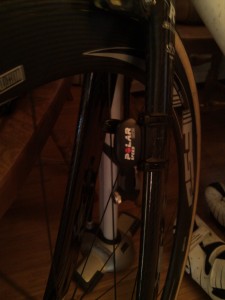
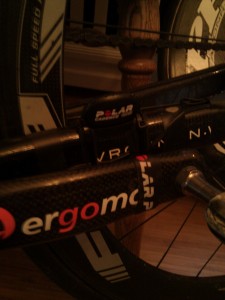
Unfailingly the RCX5 did it’s job. It captured and reported the data flawlessly. Also of note, the dual mode hrm strap works with my power meter, so I only had to wear 1 hrm strap to get both cpu’s receiving heart-rate telemetry.
Other Features
One of the features that I didn’t spend a lot of time with on the RCX5 is the Zone Optimizer. I go for regular VO2Max testing and so have a much more accurate view of my HR zones than the Zone Optimizer could offer, yet as a test I did take it out for a run to see what it’d tell me. The zone optimizer measures your HR and activity as you are guided through some warmup steps. Based on how your body reacts to the warmups it sets a heart rate zone profile for you. In the small test I did it was surprisingly accurate. Certainly close enough for the average, not completely hung up on data, recreational athlete. I believe that the zone optimizer also takes past workout history data into account, so in theory, the more one used it, the more accurate it’d become.
I really love the customizable displays on the RCX5. Each sport has up to 6 workout displays that you can customize to display the data you most want to see at any given time. This is pretty slick and a smart use of a modern individually addressable lcd pixel display. My 2 favorite additions to the display were 2 graphs. One that shows graphically which HR zone you’re currently in and another graph that shows, for the workout, the distribution of your heart rate data broken down by zone.
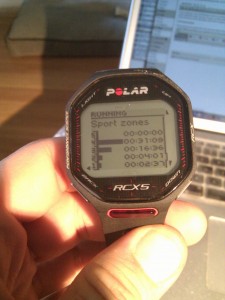
Race Day
On July 16th I raced in the Gravenhurst Olympic Distance Triathlon (and then did a 10k training run afterwards). I decided to wear the RCX5 for the race as a final test. As before swim, bike and run data were captured without fail. Transitioning between 1 event and another is not quite as clean as the Global Trainer in it’s multisport mode and the RCX5 doesn’t capture transition timing (at least not obviously to me), but the RCX5 certainly was not at all cumbersome in this regard, it just required perhaps a few seconds more focus than the Timex (a happy compromise to get HRM data in the water and only wear 1 HRM strap on the bike I may add).
My Wish List
My wish list for the RCX5, all things that can be worked around without a lot of fuss btw:
- Multiple HR zone profiles: it’d be nice to be able to share an expensive piece of equipment like this between myself an my wife or, in my case, knowing that my HR zones are different between the 3 different sports being able to have HR zones tied to sport profiles would be AMAZING. No device on the market today has this feature and probably very few athletes would care, but I do 🙂
- Data sync between Polar’s website and TrainingPeaks, DailyMile, etc.
Final Thoughts
In summary, I think the RCX5 is a pretty great piece of technology. Unfortunately, I couldn’t test it with the GPS module, but I believe that with the GPS module and google maps, you could address the lack of altitude change capture by comparing your workout data to elevation change data from the mapping source. The RCX5’s modern technology, modular approach and flawless functionality make it a strong contender in the multi-sport space.
Thanks to Polar for the opportunity to evaluate this leading edge piece of gear!
Posted on Jul 08, 2011 under Curiosities, Factoids, Geek Out! |
I’ll jump straight to the answer…
Read more… »
Posted on Jul 07, 2011 under Geek Out! |
Here in the “Great White North” riding a cycle trainer is a reality of Ironman (and any triathlon) training for at least 4 months of the year. I mean, who’s going to take their beautiful carbon fibre bike, or even a street bike onto icy streets and try to do tempo intervals in the -15C. Not me! Probably not you either!
So what do we do? We ride trainers in our pain-caves, of course. If you’re fortunate enough, you have a VR trainer like a Tacx or a Computrainer and you can break up the monotony of hours in the saddle by riding the actual course for Ironman Canada or some other race.
Well, there’s a new player in the space, and I have to say based on the press-release info, this is one heck of a machine and it’s in roughly the same price point as the aforementioned trainers. At the same price point, but does SO much more.
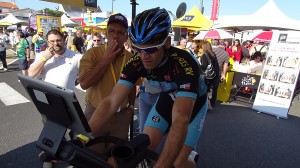
ProForm Introduces Official Le Tour de France® Training Bike
Not only is this a full featured trainer, but it allows you to ride any course that google maps has data for!!! No buying additional map packs or waiting for the newest race course to be released. If gmaps has it, so do you!!! It also… inclines and declines to simulate climbing and descending hills AND adjusts resistance to simulate WIND RESISTANCE!! On top of it all, it measures power – super important to those of us who train based on power output! Ok really! I need to have one of these!
Additional features:
- Power meter
- RPM meter
- Multiple position adjustable handlebars
- Two-way seat adjustment
- Console display of watts, speed, pace, time, resistance level, rpm, heart rate, percent incline/decline, distance, vertical feet, and calories per hour
- Polar® wireless chest pulse compatible. Receiver included. Chest strap available for purchase or you your own.
- Two-way pedals with clipless pedals on one side and toe cages on the other
- Built-in wireless makes the ProForm Tour de France bike an internet appliance and “smart fitness” equipment
- iPod jack and built-in speakers
- Multiple position adjustable handlebars
- Water bottle holder in a convenient location on the frame
- Compact footprint of 58 inches long by 25 inces wide by 59 inches tall.
- Wheels on front of frame for easy movement within the home.
I’ve contacted proform to see if I can get an evaluation unit to review for the community. They’re still waiting for shipments, but I remain hopeful. I’ll let you know what I hear from them as units become available.
I’ll leave you with a video of the trainer “in action”, just to whet your whistle as much as mine is 🙂
dailies from Le Tour de France from Icon Health & Fitness Studios on Vimeo.
Posted on Jun 04, 2011 under fitness, Geek Out! |
Do you bike train with a power meter? If you can afford to get one, I strongly recommend it. Heart-rate is ok, but it’s decoupled from the level of effort you’re putting out and just time and perceived intensity is way too subjective.
If you are training with a power meter, I encourage you to checkout Golden Cheetah: Cycling Performance Software for Linux, Mac OS X, and Windows.
It’s an open-source analytics package for cycling power data. It provides a LOT of great information AND it’s FREE!
Posted on Jun 03, 2011 under fitness, Geek Out! |
How many of you, when mixing your powdered sport nutrition end up with a slurry of clumpy, unmixed product glued to the bottom of the bottle, that seemingly won’t dissolve, no mater what you do?
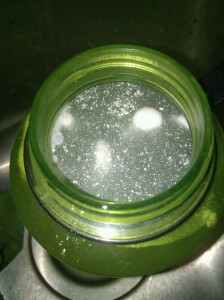
Annoying? Yes! But I have a solution to get it into solution 🙂
There’s more than 1 of you frustrated souls out there I know it! Because I used to be one. Until I figured out this sure-fire method for mixing that hasn’t yet let me down. I’m going to give instructions based on 1 bottle, but the process is the same for more (obviously).
- Collect your water bottles and lids, powdered supplements, measuring devices, near your water source before you start. Having a large time gap in this process almost guarantees problems.
- Fill the water bottle 50-60% full of water (or whatever your liquid substrate layer is – I almost always use water, I expect you do as well)
- Add 6 to 8 ice cubes
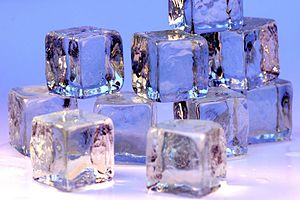
Image via Wikipedia
- Add your powdered nutrition, electrolyte, aminos, supplements, etc. quickly after the ice goes in
- Once the powder and ice are in the water, get the lid on the bottle and shake vigorously. The ice cubes act as an agitation aide in the bottle and help to get the powders mixed quickly without clumping. Note, if you use a LOT of powdered supplements, you may need to do steps 3-5 multiple times with less powder in each step, than doing a lot of powder at once (which will almost guarantee problems again).
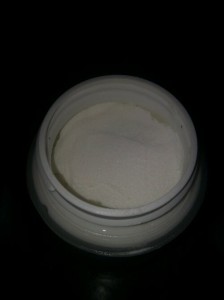
This doesn't work very well...
- Once the ice cubes and water have successfully dissolved the powder, you can top off the bottle with additional water
Enjoy! This has worked flawlessly for me since I figured it out several months ago. I find it much easier than shaking my arms off 1st thing in the morning when trying to get that last bit of product to dissolve.
Try it out and let me know how it works for you!
Posted on Jan 28, 2011 under fitness, Geek Out!, nutrition |
Realized this morning while I was showering, post swim, that I’m really hooked on data and using it effectively to inform and guide my training toward Ironman Muskoka this fall.
At times I feel a bit like a cyborg, but I really think that the data-driven results don’t lie. Here’s the current level of my cyborg-y-ness:
A few words about each of these tools and the data they provide me:
Bodybugg
The bodybugg, through a bunch of different sensors, tells you how many calories you’re actually burning while sleeping, awake, exercising, watching TV, what have you. They claim it’s 95% accurate, and to me, 95% is way better than generalized estimates based on METS or some other random equation. Unfortunately the bodybugg doesn’t work in the water (and isn’t waterproof) so it’s off and in the locker when I’m swimming.
I started with the bodybugg and the wrist receiver and “upgraded” to the bodybuggSP when it came out. The SP is still pretty rough around the edges on my Android phone, but they’re working on it. Had I known I’d be paying to beta test their software, I’d have probably waited. There are still nagging issues with the trip functions of the software on Android that are pretty annoying.
The great thing about the bodybugg is that, because you know what you’re burning, you can eat appropriately. Making sure you consume the right amount of nutrition to keep the machine functioning efficiently. More on nutrition in a minute.
Timex Global Trainer
Probably the biggest watch on the planet, the Global Trainer is an ANT+ compatible HRM, bicycle computer, and GPS device. I really like it, it does a great job, of tracking my heart-rate, speed, distance and on the bike cadence (and speed while in the trainer).
Recently I went for VO2max testing with Ian at ImFit.ca, so now I can really dial in my training to target my aerobic capacity and work at moving my anerobic base. Good stuff.
If I had an ANT+ powermeter, the Global Trainer would integrate with that too and provide even more (super useful) data to help guide my training. I’m not sure if Computrainers are ANT+ compatible, but if they were this would be über! 😉 No, I don’t currently own a computrainer, but Racermate is having a contest at the moment, so if I’m really lucky, I may win one combined with a year’s training!
The computrainers provide even more data that I’d love to sink my teeth into, like pedal stroke analysis, power output and a whole slew of others. All that combined with virtual-reality interactive cycling that would certainly make the miles pass by faster.
Sportcount
When I’m swimming I probably have the least tech helping me out and gathering data. Currently I just have a (blue) sportcount lap counter. This gives me average, fastest, slowest and total swim times and that’s about it. It’s a useful tool because after the 40th or so lap, I generally lose count. That, and counting laps tends to pull me away from focusing on technique or just zoning out to the swim. So, while not providing a lot of data, the sportcount is still super useful.
Now, Finis have released the Swimsense, which looks pretty amazing! Unfortunately with all the other training and gear expenses (read: desires for a time-trial bike), a swimsense just isn’t in the budget. Perhaps Finis would loan me one for a blog review (ahem! nudge, nudge).
TrainingPeaks.com
TrainingPeaks seems to be pretty much the de facto online tool for endurance athletes. It’s feature rich with a lot of graphs and analytics for monitoring your training, stress levels, diet, weight, nutrition over time. I generally like the site now that I’m getting used to it. It’s cool that my Timex Global Trainer interfaces directly with the site and that my coach can directly see my workouts, plan sessions for me, see my nutrition info, etc. Pretty slick.
My biggest complaint with trainingpeaks.com is that it’s built in flash. Flash was probably a great choice 5-8 years ago before html5, ajax, javascript and modern browsers, but now flash just makes websites hostile and heavy weight. Hopefully someday they fix this, but for now, I’ve grown used to the odd quirks and slow load times.
I track my workouts, my bodybugg daily data, and nutrition on trainingpeaks.com. So, onto Nutrition:
Those of you who know me, know that in Aug of 2009 I was a “pretty big guy”™. I tipped the scale at just over 250lbs and, while I considered myself pretty fit (for a guy my size) I was a long way from being a healthy weight. My wife and I did the Dr. Bernstein diet for 4 months and I lost 85lbs. More important than the weightloss, I discovered things about my diet and how I related to food and most importantly, how my body reacts to specific foods. I now maintain a diet that I strictly monitor. I closely track sodium, and the 3 macronutrients (fat, carb, and protein). My daily nutrition plan isn’t really set in stone, but does follow some pretty hard guidelines, as follows:
- I target a 500 calorie deficit based on activity and bodybugg data, I (try to) measure by weight (uncooked) all food that I eat
- I eat <= 15% of my daily calories from fat (good fat, bad fat, doesn't matter, just <= 15%)
- I try to eat between 120 and 150g of protein daily
- I fill the rest of the calories with carbs, typically of the veg variety. I stay away from processed grains as my body doesn’t react well to them (breads, pastas).
- I limit my sodium (or try to) to less than 2000mg daily – more and I bloat like the “Staypuff Marshmellow Man”
That’s about it, I’m pretty anal about it, but it gives me a lot of room to play too. I definitely don’t feel constrained by it and eating in this plan keeps my energy levels up, my digestive system happy, and my bloat down.
Have to say, I’m pretty happy with my feedback system. There are some places I’d love to improve it if I had the funds, but I definitely feel armed with more than ample data to guide me strongly forward to Ironman Muskoka.
Oh… and just because I have to… I am Iron..Man… 😀
Posted on Nov 13, 2009 under Geek Out! |
Some friends of mine are working on a startup. It’s a shift-sharing site called workflip.com.
I think it’s a great idea and they’re approaching it in a really strong way. I think they’ll do really well. They’re almost ready to start taking names for their beta. If you’re a shift worker, keep an eye on this one.
 The Aquapulse clips onto the strap of your swim goggles and onto your earlobe. It uses a beam of light through your lobe to sense your heart-rate and speaks it via bone conduction into your head.
The Aquapulse clips onto the strap of your swim goggles and onto your earlobe. It uses a beam of light through your lobe to sense your heart-rate and speaks it via bone conduction into your head.








